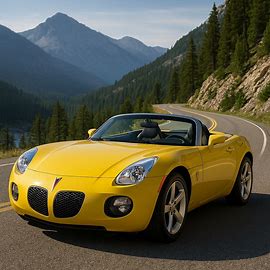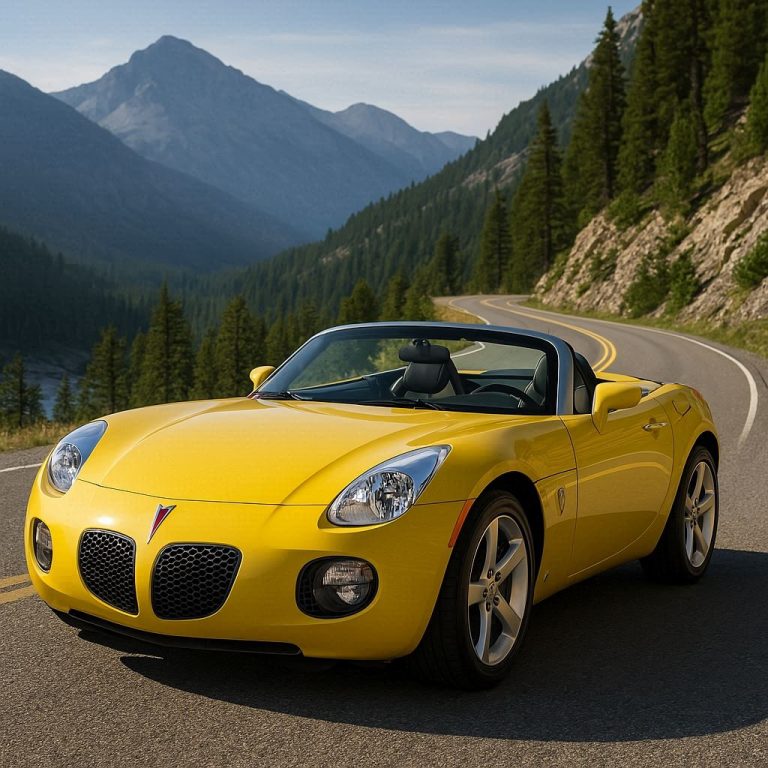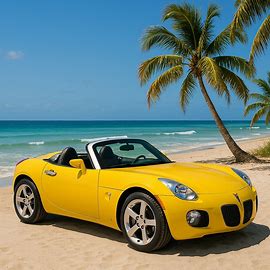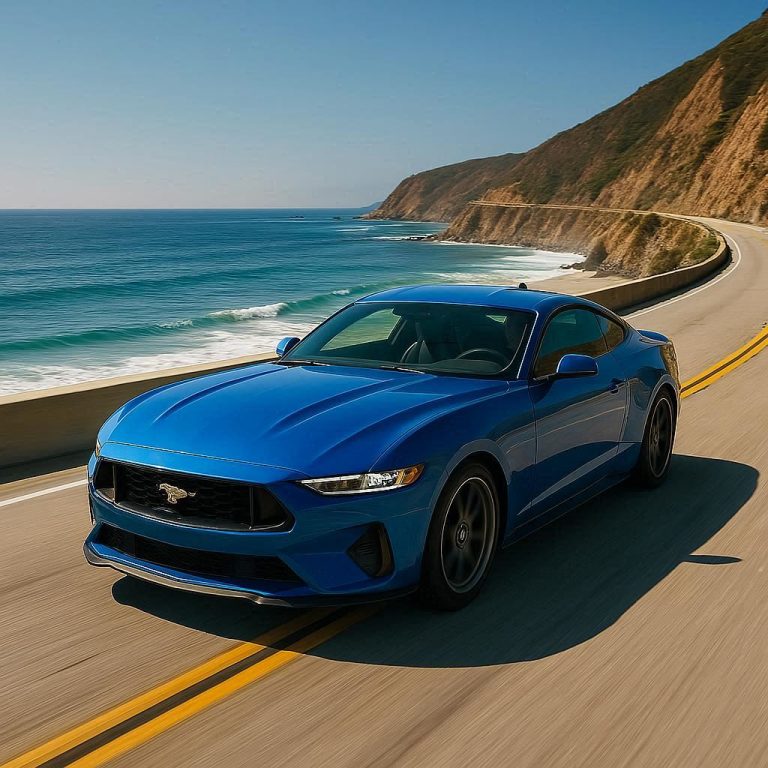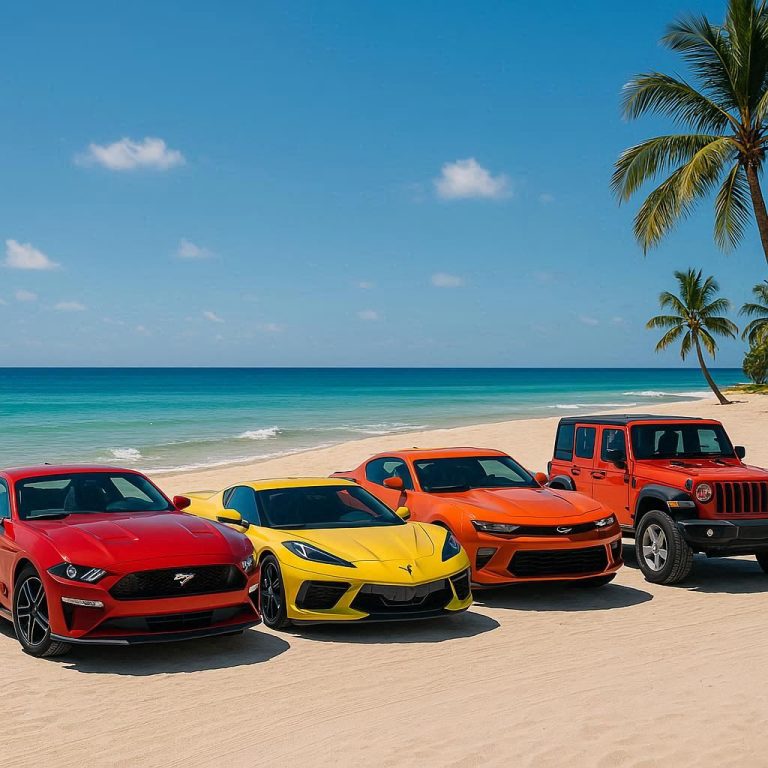
Chapter 5: Future of American Automotive Passion
Electric Vehicle Revolution
Electric vehicles aren’t just a blip on the radar anymore; they’re fundamentally changing what it means to be a car enthusiast in America.
The story of EVs isn’t a new one. Back in the late 1800s and early 1900s, electric cars were actually quite popular, even more so than gasoline vehicles in some cities. They were clean, quiet, and easy to operate, which was a big deal when gasoline cars required hand-cranking and were notoriously noisy. Companies like Baker and Riker produced elegant electric carriages, catering to a wealthier clientele. However, several factors led to their decline. The discovery of abundant oil reserves made gasoline cheap and readily available. The invention of the electric starter by Charles Kettering made gasoline cars easier to use. And Henry Ford’s mass production techniques made the Model T incredibly affordable, something electric car manufacturers couldn’t compete with at the time. For decades, EVs faded into obscurity, becoming a footnote in automotive history.
But the dream of electric mobility never completely died. Throughout the 20th century, inventors and engineers tinkered with electric vehicle technology, often driven by concerns about air pollution and energy security. In the 1970s, rising gas prices and environmental awareness spurred renewed interest in EVs, but battery technology remained a major limitation. Cars like the Citicar were small, slow, and had limited range, hindering widespread adoption. It wasn’t until the late 20th and early 21st centuries that advances in battery technology, particularly lithium-ion batteries, finally made EVs a practical option. The General Motors EV1, launched in the 1990s, was a bold experiment, showcasing the potential of electric cars. However, GM ultimately discontinued the EV1 program, crushing the vehicles and halting development. It became a cautionary tale about the challenges of introducing disruptive technology.
Today’s EV revolution is built on decades of research and innovation. Lithium-ion batteries have dramatically improved energy density, allowing for longer ranges and better performance. Advancements in battery management systems (BMS) optimize battery life, safety, and efficiency. Fast charging technology is also evolving quickly, with companies deploying high-power charging stations that can add hundreds of miles of range in a relatively short time. Tesla, in particular, played a huge role in driving these technological advancements, pushing the boundaries of battery technology, motor design, and charging infrastructure. Their Supercharger network became a key selling point, providing owners with a convenient and reliable way to travel long distances.
But it’s not just about batteries and charging. Electric motors are much more efficient than internal combustion engines, converting a higher percentage of energy into motion. They also provide instant torque, resulting in quick acceleration and a different kind of driving experience. Automakers are pushing the boundaries of performance, with EVs now capable of outperforming traditional sports cars. Sophisticated regenerative braking systems capture energy during deceleration, further improving efficiency. Over-the-air software updates allow manufacturers to continuously improve vehicle performance, add new features, and fix bugs, transforming the car into a constantly evolving platform.
The shift to EVs is having profound effects on American automotive culture. For generations, car enthusiasm has been closely tied to the sound, feel, and smell of gasoline engines. The rumble of a V8, the precise shifting of a manual transmission, the smell of burning rubber – these are all sensory experiences that have defined the car experience for many people. Now, with EVs, those experiences are changing. The instant torque and silent acceleration of an electric motor provide a different kind of thrill. Some find it sterile, missing the raw emotion of a combustion engine, while others embrace the new level of performance and refinement.
Manufacturers are trying to bridge this gap by creating artificial engine sounds and incorporating sporty design elements. However, it remains to be seen whether these efforts will fully satisfy traditional car enthusiasts. Many are warming up to the idea, appreciating the technology and performance benefits of EVs. Drag racing, for example, has seen a growing number of electric vehicles competing and setting records. The focus is shifting from engine displacement to horsepower and acceleration times, leveling the playing field between EVs and gasoline cars.
EVs are reshaping automotive identity in other ways as well. The rise of Tesla has created a new kind of car enthusiast, one who is drawn to technology, sustainability, and a minimalist aesthetic. Tesla owners often see themselves as part of a community, connected through their shared values and their belief in the future of electric transportation. Online forums and social media groups provide a space for them to share their experiences, discuss modifications, and organize events. Other EV manufacturers, like Rivian and Lucid, are also cultivating their own unique brand identities, attracting customers who are looking for something different from the traditional automakers.
The big American automakers are also playing a key role in the EV transition. General Motors, Ford, and Stellantis (formerly Chrysler) have all announced ambitious plans to electrify their lineups, investing billions of dollars in new EV platforms and battery manufacturing facilities. Ford’s Mustang Mach-E, for example, has been a success, combining the iconic Mustang name with an all-electric powertrain. GM’s Cadillac Lyriq is a luxurious electric SUV that is aimed at competing with Tesla and other premium brands. These manufacturers are leveraging their existing brand recognition and manufacturing expertise to compete in the EV market, but they also face the challenge of adapting their traditional business models and corporate cultures to the new realities of electric transportation.
Environmental motivations are a major driver of EV adoption. Concerns about climate change, air pollution, and energy independence are pushing consumers to consider electric vehicles. Governments are also playing a role by offering incentives, such as tax credits and rebates, to encourage EV purchases. Regulations, such as stricter emissions standards and bans on the sale of gasoline cars, are also accelerating the transition to electric mobility. However, there are also challenges to overcome. The environmental impact of battery production and disposal is a concern, and efforts are underway to develop more sustainable battery technologies and recycling processes. The availability of charging infrastructure is also a barrier to adoption, particularly in rural areas and apartment buildings.
The shift to EVs also raises questions about the future of the automotive industry. Electric cars require fewer parts and less maintenance than gasoline cars, which could lead to job losses in manufacturing and service sectors. New skills will be needed to design, manufacture, and service electric vehicles, requiring investments in education and training. The rise of software and connectivity in cars is also transforming the role of automakers, turning them into technology companies. They need to adapt to this new reality by developing new business models and investing in software engineering and data analytics.
Electric vehicles represent both a technological revolution and a cultural transformation in American car culture. They are challenging traditional notions of what it means to be a car enthusiast, reshaping automotive identity, and driving innovation in the automotive industry. While there are challenges to overcome, the transition to electric mobility is well underway, promising a cleaner, more sustainable, and more technologically advanced future for American car culture. The sound of silence, once anathema to car lovers, is becoming the sound of progress.
Technology and Modification
American car culture isn’t just about wrenches and carburetors anymore; it’s increasingly about code and computers. Where once a gearhead might spend hours under the hood, tweaking timing and adjusting valves, today they’re just as likely to be hunched over a laptop, remapping engine control units (ECUs) and downloading performance enhancements. This shift towards digital customization marks a profound change in how we modify and personalize our cars, reflecting both technological advancements and the evolving tastes of a new generation of enthusiasts.
The move from mechanical to digital modification isn’t an overnight thing; it’s an ongoing evolution. Think back to the old days: you wanted more power? You swapped out the camshaft, installed a bigger carburetor, maybe even ported and polished the cylinder heads. It was a hands-on process, requiring skill, experience, and a good set of tools. Now, while those skills are still valued (and, dare I say, making a comeback), many performance gains can be achieved with software alone. A simple ECU remap can increase horsepower, improve throttle response, and even enhance fuel economy. It’s like giving your car a shot of adrenaline with just a few keystrokes.
One of the biggest changes is in engine tuning. Traditionally, tuning involved adjusting mechanical components like the distributor, carburetor jets, and timing advance. It was an iterative process of trial and error, often requiring specialized equipment like a dynamometer to measure the results. Modern engine management systems, controlled by sophisticated ECUs, offer far more precise and flexible tuning options. With the right software, tuners can adjust parameters like fuel injection, ignition timing, boost pressure (for turbocharged engines), and even valve timing (on engines with variable valve timing systems). This level of control allows for fine-tuning the engine’s performance for specific driving conditions or desired outcomes.
But it’s not just about engine performance. Digital customization extends to almost every aspect of the car, from the suspension to the infotainment system. Software can be used to adjust the ride height, stiffness, and damping characteristics of the suspension, allowing drivers to tailor the handling to their preferences. Infotainment systems can be customized with different themes, apps, and features, turning the car into a personalized entertainment hub. Even things like lighting and instrumentation can be tweaked to match the driver’s individual style.
Advanced diagnostics play a huge role in this new era of automotive personalization. Modern cars are packed with sensors that constantly monitor various systems and components. These sensors generate a wealth of data that can be used to diagnose problems, optimize performance, and even predict potential failures. On-board diagnostic (OBD) systems provide access to this data, allowing mechanics and enthusiasts to monitor things like engine temperature, fuel consumption, and emissions levels.
But it goes beyond simple fault codes. Sophisticated diagnostic tools can analyze the data in real-time, identifying subtle performance issues that might go unnoticed with traditional methods. This data can also be used to personalize the car’s performance. For example, some systems can automatically adjust the engine’s parameters based on the driver’s habits and the road conditions, optimizing fuel economy or maximizing power as needed.
Connectivity is another factor changing vehicle customization. Modern cars are increasingly connected to the internet, allowing for over-the-air software updates, remote diagnostics, and access to a range of online services. This connectivity opens up new possibilities for customization. Manufacturers can push out software updates that add new features, improve performance, or fix bugs. Third-party developers can create apps that integrate with the car’s systems, providing access to custom data displays, performance tracking tools, and other innovative features.
Think of it like your smartphone. You can customize it with different apps, themes, and settings to make it your own. Now, cars are becoming the same way. The car is transforming into a platform, where software and connectivity unlock new levels of personalization and functionality. This trend is particularly appealing to younger generations, who have grown up with technology and expect seamless integration between their digital lives and their physical experiences.
Younger enthusiasts are reshaping automotive modification in some interesting ways. For one, they’re more open to experimenting with new technologies and techniques. They’re not as tied to traditional methods, and they’re more willing to embrace digital customization as a legitimate form of self-expression. You also see a strong DIY ethos. Younger car enthusiasts are tech-savvy and enjoy tinkering with their cars themselves.
Beyond that, you see a different aesthetic. The focus is less on raw power and more on balanced performance, handling, and style. They’re drawn to cars that are not only fast but also look good and handle well. Many are also interested in eco-friendly modifications, such as converting classic cars to electric power or optimizing fuel efficiency. This focus on sustainability reflects a growing awareness of environmental issues and a desire to reduce their carbon footprint.
AI-assisted customization and predictive performance enhancement are still in their infancy, but hold huge promise. Imagine a system that uses artificial intelligence to learn your driving style and automatically adjust the car’s parameters to optimize performance and efficiency. Or a system that can predict potential mechanical failures before they occur, allowing you to schedule maintenance proactively. We’re not quite there yet, but the technology is rapidly advancing, and it’s only a matter of time before these kinds of features become commonplace.
The intersection of technological innovation and passionate automotive expression is creating a dynamic and exciting new chapter in American car culture. While some may lament the loss of traditional mechanical skills, there’s no denying the power and potential of digital customization. It’s opening up new avenues for creativity, personalization, and performance, and it’s attracting a new generation of enthusiasts to the hobby. The sound of the engine may be changing, but the passion for cars remains as strong as ever. The key is finding a balance – respecting the history and tradition of car culture while embracing the possibilities of the future. The hot rod of tomorrow might just have a keyboard plugged into it.
Sustainable Performance
Electric vehicles are grabbing headlines, but true automotive passion isn’t about to vanish; it’s evolving, morphing, and finding new expression in a world that demands both speed and responsibility. We’re on the cusp of a new era: sustainable performance. It’s about building cars that thrill the senses without punishing the planet, machines that are as kind to the environment as they are exhilarating to drive.
So, what does this new breed of performance car look like? It’s more than just slapping an electric motor into an existing chassis. Sustainable performance demands a rethink from the ground up, a marriage of cutting-edge technology and a deep understanding of ecological principles.
Let’s start with the tech. Hybrid powertrains are already commonplace, but they’re becoming increasingly sophisticated. Forget the early hybrids, designed primarily for fuel economy. The latest systems are engineered for performance, using electric motors to boost acceleration, fill in torque gaps, and even provide all-wheel drive capabilities. Think of cars like the Acura NSX or the BMW i8 – these aren’t just fuel sippers; they’re serious performance machines that happen to be relatively efficient. Plug-in hybrids take it a step further, offering a decent amount of all-electric range for daily commuting, combined with the reassurance of a gasoline engine for longer journeys.
Of course, the real revolution is happening in the all-electric realm. Early EVs were often criticized for being slow, boring, and having limited range. But that’s changing fast. Companies like Tesla have proven that electric cars can be incredibly quick, with instant torque and blistering acceleration that can rival even the most potent gasoline-powered machines. And with advancements in battery technology, range anxiety is becoming a thing of the past. Modern EVs can travel hundreds of miles on a single charge, making them practical for long road trips.
But it’s not just about straight-line speed. Many EVs handle surprisingly well, thanks to their low center of gravity (due to the battery pack being mounted low in the chassis) and sophisticated electronic stability control systems. Some EVs even feature torque vectoring, which can precisely control the amount of power sent to each wheel, improving cornering ability and overall agility.
Beyond the powertrain, sustainable performance demands a focus on ecological engineering. This means designing cars with the environment in mind, from the materials used to the manufacturing processes employed. Automakers are increasingly using lightweight materials like aluminum, carbon fiber, and even composites made from recycled materials to reduce the overall weight of the car, improving both fuel efficiency and performance.
Aerodynamics also play a crucial role. Sleek, streamlined designs can reduce drag, improving fuel economy and increasing top speed. Active aerodynamics, such as adjustable spoilers and air dams, can further optimize airflow for different driving conditions. And it’s not just about reducing drag; it’s also about managing airflow to improve cooling and downforce, enhancing handling and stability.
Sustainable manufacturing processes are also essential. Automakers are investing in more efficient factories that use less energy, water, and raw materials. They’re also exploring ways to reduce waste and recycle materials, creating a closed-loop system that minimizes their environmental impact. Some companies are even using renewable energy sources, such as solar and wind power, to power their factories.
But what about the sound? For many enthusiasts, the roar of an engine is an integral part of the driving experience. Electric cars, of course, are virtually silent. Some manufacturers are adding artificial sounds to EVs to provide auditory feedback and enhance the driving experience. But is it the same? That’s a matter of personal preference. Some drivers appreciate the quietness of an electric car, while others miss the visceral thrill of a gasoline engine. It’s a challenge that automakers are still grappling with, trying to find ways to create an engaging and satisfying auditory experience in an electric vehicle.
The economic side of sustainable performance is complex. Electric cars typically have a higher upfront cost than gasoline-powered cars, due to the expense of the battery pack. However, the total cost of ownership can be lower, due to reduced fuel costs and maintenance requirements. Electric cars don’t need oil changes, spark plugs, or other routine maintenance items that gasoline cars require. And with government incentives, such as tax credits and rebates, the cost of an EV can be significantly reduced.
The market for sustainable performance cars is growing rapidly. As battery technology improves and costs come down, EVs are becoming more affordable and accessible. And as more consumers become aware of the environmental benefits of EVs, demand is likely to continue to increase. Automakers are responding to this demand by introducing a wider range of electric and hybrid models, catering to different tastes and budgets.
Traditional performance metrics, such as horsepower and 0-60 mph times, are still relevant in the world of sustainable performance. But new benchmarks are also emerging. Electric car performance is often measured in terms of torque, which is the rotational force that propels the car forward. Instant torque is a key characteristic of electric motors, providing incredibly quick acceleration. Range is another important metric, indicating how far the car can travel on a single charge. Efficiency is also a key consideration, measured in terms of miles per gallon equivalent (MPGe), which compares the energy consumption of an electric car to that of a gasoline car.
Regenerative braking is another interesting element. When you lift off the accelerator in an EV, the motor acts as a generator, converting the car’s kinetic energy back into electricity and storing it in the battery. This not only helps to slow the car down but also extends the range. Some EVs even allow you to adjust the level of regenerative braking, allowing you to drive with one pedal – simply lift off the accelerator to slow down, and press it again to accelerate.
But how do consumers really feel about this shift? There’s still a segment of enthusiasts who will always prefer the sound, the smell, and the feel of a classic gasoline-powered car. But there’s also a growing number of drivers who are embracing sustainable performance. They appreciate the instant torque, the quietness, and the environmental benefits of electric cars. They’re also drawn to the cutting-edge technology and the sleek, modern designs.
Consumer attitudes are also influenced by factors such as government policies, infrastructure availability, and social trends. Government incentives can make EVs more affordable, while the expansion of charging infrastructure can alleviate range anxiety. And as more people see their friends and neighbors driving EVs, it becomes more socially acceptable and even desirable to own one.
The breakthrough technologies that are enabling eco-friendly high-performance vehicles are constantly evolving. Solid-state batteries, for example, promise to offer higher energy density, faster charging times, and improved safety compared to traditional lithium-ion batteries. Wireless charging is another promising technology, allowing drivers to simply park their car over a charging pad to replenish the battery. And autonomous driving technology has the capacity to make driving safer and more efficient, reducing energy consumption and emissions.
There will always be those who resist change, who cling to the past and dismiss new technologies as fads. But the trend toward sustainable performance is undeniable. It’s not just about being environmentally responsible; it’s also about building cars that are better in every way – quicker, more efficient, more technologically advanced, and more enjoyable to drive.
It’s a shift from loud and brash to sleek and smart; from burning rubber to generating kilowatts. This isn’t just about saving the planet, it’s about enhancing the driving experience. It’s about crafting machines that not only perform at the highest level but also integrate seamlessly with a more responsible and sustainable future. The evolution of car culture isn’t ending, it’s just getting a whole lot more interesting.
Generational Car Appreciation
The love of cars isn’t dying, but it’s certainly changing, shaped by each generation’s unique experiences and values. Understanding how Baby Boomers, Gen X, Millennials, and Gen Z view automobiles offers a fascinating glimpse into the evolving heart of American car culture.
For Baby Boomers, born roughly between 1946 and 1964, cars represent freedom, status, and the open road. They grew up during the golden age of American automotive manufacturing, when powerful V8 engines and chrome-laden designs ruled the streets. Boomers came of age alongside iconic vehicles like the Ford Mustang, Chevrolet Corvette, and Pontiac GTO – machines that symbolized rebellion, individuality, and the boundless possibilities of American life. Their connection to cars is often deeply emotional, tied to memories of family road trips, cruising with friends, and working on their vehicles in the garage. Boomers tend to value reliability, performance, and classic styling. They appreciate the visceral experience of driving, the rumble of the engine, and the feeling of connection to the machine. Restoration projects and classic car shows are popular pastimes, allowing them to relive their youth and share their passion with others. For many, these are more than just cars; they’re tangible links to a bygone era.
Gen X, born between 1965 and 1980, experienced a different automotive landscape. They witnessed the rise of Japanese imports, the oil crisis of the 1970s, and the increasing focus on fuel efficiency and safety. While they still appreciate performance, Gen Xers are often more practical and pragmatic in their car choices. They value reliability, affordability, and versatility. Minivans and SUVs became popular choices for growing families, reflecting their need for functional and spacious vehicles. However, Gen X also embraced the tuner culture, modifying Japanese cars for improved performance and handling. The Fast and the Furious film franchise resonated strongly with this generation, showcasing the excitement and camaraderie of the import scene. Gen Xers are often tech-savvy and appreciate modern conveniences like CD players, power windows, and anti-lock brakes. They represent a bridge between the old-school mechanical appreciation of the Boomers and the digital natives of the Millennial generation.
Millennials, born between 1981 and 1996, came of age in a world dominated by technology and globalization. They grew up with the internet, smartphones, and social media, which have profoundly impacted their relationship with cars. Millennials are often less interested in car ownership than previous generations, due to factors like rising costs, urbanization, and the availability of alternative transportation options like ride-sharing services and public transit. They are more likely to prioritize experiences over material possessions, and they may view cars as a necessary expense rather than a status symbol. However, those Millennials who are passionate about cars tend to be drawn to fuel-efficient vehicles, hybrid cars, and electric cars, reflecting their concern for the environment. They also value technology and connectivity, seeking cars with advanced infotainment systems, smartphone integration, and driver-assistance features. Millennials are digital natives, comfortable with using technology to research, purchase, and maintain their cars. They often rely on online reviews, social media, and mobile apps to make informed decisions. They also value personalization and customization, using technology to tailor their cars to their individual needs and preferences.
Gen Z, born after 1997, is the first generation to have grown up entirely in the digital age. They have never known a world without the internet, smartphones, and social media. Gen Z’s relationship with cars is still evolving, but early trends suggest that they are even less interested in car ownership than Millennials. They are highly environmentally conscious and are drawn to sustainable transportation options like electric scooters, bicycles, and public transit. When they do need a car, they are more likely to use ride-sharing services or car-sharing programs rather than buying their own vehicle. However, Gen Z also appreciates the convenience and freedom that cars can offer, particularly in suburban and rural areas. Those who are passionate about cars tend to be drawn to electric vehicles and autonomous vehicles, reflecting their interest in technology and sustainability. They are also highly influenced by social media and are likely to be drawn to cars that are visually appealing and Instagram-worthy. Customization and personalization are also important to Gen Z, and they often use technology to express their individuality through their cars.
The shift from mechanical appreciation to technological fascination is a key trend shaping generational car enthusiasm. Baby Boomers and Gen Xers grew up working on their cars, understanding the mechanics of engines, transmissions, and suspensions. They valued the hands-on experience of tuning and modifying their vehicles, and they took pride in their mechanical skills. Millennials and Gen Z, on the other hand, are less likely to have this hands-on experience. They are more comfortable with using technology to diagnose and repair their cars, relying on computers and software to troubleshoot problems. They are also more likely to be interested in digital modification, using software to remap ECUs, personalize infotainment systems, and adjust suspension settings. This shift reflects the increasing complexity of modern cars, which are now equipped with sophisticated electronic systems that require specialized knowledge and tools to maintain.
Economic and environmental concerns also play a significant role in shaping generational automotive preferences. Rising car prices, insurance costs, and fuel costs have made car ownership less affordable for younger generations. Millennials and Gen Z are also more likely to be burdened with student loan debt, which further limits their ability to afford a car. Environmental concerns are also a major factor, as younger generations are more aware of the impact of cars on air pollution and climate change. They are more likely to choose fuel-efficient vehicles, hybrid cars, and electric cars in an effort to reduce their carbon footprint. Government incentives and regulations, such as tax credits for electric vehicles and stricter emissions standards, also influence generational automotive preferences.
The rise of ride-sharing, autonomous vehicles, and digital connectivity are also transforming American car culture. Ride-sharing services like Uber and Lyft have made it easier and more affordable for people to get around without owning a car. Autonomous vehicles have the potential to revolutionize transportation, making it safer, more efficient, and more accessible. Digital connectivity is transforming the driving experience, with cars becoming increasingly integrated with the internet and other devices. These trends are likely to have a profound impact on generational automotive preferences, as younger generations become more accustomed to using alternative transportation options and relying on technology to get around.
The future of automotive enthusiasm across generations is uncertain, but it is clear that the love of cars is not going away. While younger generations may be less interested in traditional car ownership, they are still passionate about mobility, technology, and personalization. The challenge for the automotive industry is to adapt to these changing preferences by offering vehicles and services that appeal to younger generations. This includes developing electric vehicles, autonomous vehicles, and connected car technologies that are both environmentally friendly and technologically advanced. It also includes offering flexible ownership options, such as car-sharing programs and subscription services, that make it easier for younger generations to access the benefits of car ownership without the commitment of buying a vehicle.
The industry will need to foster a sense of community and excitement around cars, appealing to younger generations’ desire for social connection and self-expression. This could include organizing car shows, meetups, and online forums that allow enthusiasts to share their passion for cars and connect with like-minded individuals. Ultimately, the future of American car culture will depend on the ability of the automotive industry to adapt to the changing needs and preferences of each generation.
Preserving Automotive Heritage
Preserving the legacy of car culture in a world that’s constantly speeding toward the future isn’t just about keeping old cars running; it’s about safeguarding a vital piece of American history and identity.
One key piece of this is looking at what museums and restoration projects are doing. These aren’t just static displays of metal and rubber; they’re living, breathing stories brought to life. Take the Petersen Automotive Museum in Los Angeles, for example. It isn’t just a repository of cool cars; it uses interactive exhibits and educational programs to engage visitors of all ages, from wide-eyed kids to seasoned gearheads. It has rotating exhibitions highlighting everything from the evolution of the hot rod to the artistry of Italian design. These kinds of efforts matter because they make automotive history accessible and exciting, turning passive viewers into active participants. Restoration projects, whether undertaken by museums or private collectors, are a different, but equally important piece of the puzzle. When a team of dedicated mechanics and historians painstakingly brings a rusted-out classic back to its former glory, they’re not just fixing a car; they’re resurrecting a piece of history. They’re reverse-engineering the ingenuity of the original designers, learning about the materials and techniques of the past, and preserving a tangible link to a different era.
But keeping car culture alive isn’t just about preserving the physical artifacts; it’s also about capturing the stories and experiences that go along with them. That’s where digital archiving comes in. Imagine a future where every car, every race, every road trip, and every late-night wrenching session is documented in high-definition detail, available for anyone to explore at the click of a button. That’s the promise of digital archiving. We’re talking about scanning original documents and photos, recording oral histories with the people who lived through these times, and creating virtual models of classic cars that can be explored inside and out. The National Historic Vehicle Register, for example, is doing impressive work documenting historically significant vehicles. They’re not just taking pictures; they’re creating detailed records that capture the car’s provenance, its mechanical specifications, and its place in automotive history. And with the rise of virtual reality and augmented reality, the possibilities for digital archiving are endless. Imagine being able to virtually sit behind the wheel of a Duesenberg Model J, or walk through the Ford factory as the first Model T rolled off the assembly line.
That raises the question, how can we make sure the next generation gets just as excited about cars as previous ones did? Because let’s face it, in a world of smartphones and social media, a lot of kids just don’t seem to care about cars the way their parents or grandparents did. One way is through education. Schools can incorporate automotive history and technology into their STEM programs, showing students how cars work, how they’re designed, and how they’ve shaped our world. Hands-on programs that allow kids to build and race their own cars can be incredibly effective in sparking their interest. But it’s not just about formal education; it’s also about creating opportunities for young people to experience the fun and excitement of car culture firsthand. Car clubs can organize events specifically for kids, like build-a-car workshops, model car competitions, and ride-alongs in cool cars. Video games and online communities can also play a role, providing a virtual space for young people to explore their passion for cars and connect with other enthusiasts.
Classic car events and communities also do their part in keeping the flame alive. These aren’t just gatherings of old cars; they’re celebrations of automotive history and culture. Events like the Pebble Beach Concours d’Elegance and the Goodwood Revival attract enthusiasts from all over the world, showcasing some of the most beautiful and historically significant cars ever built. But it’s not just about the high-end events; local car shows and cruise nights are just as important in fostering a sense of community and sharing the passion for cars. These events provide a platform for people to show off their pride and joy, swap stories, and connect with other enthusiasts. Car clubs play a vital role in organizing these events, providing a network for enthusiasts to connect, share knowledge, and support each other. They also often engage in charitable activities, using their love of cars to give back to the community. These clubs and events demonstrate how cars are more than just machines; they’re sources of joy, connection, and community pride.
We also have to remember the more nitty-gritty side of car preservation: the actual techniques and processes to preserve automotive artifacts. This involves a range of specialized skills, from metalworking and paint restoration to upholstery repair and mechanical rebuilds. Restoring a classic car is often a delicate balancing act between preserving its original character and making it safe and reliable for modern use. Detailed documentation is crucial, with restorers carefully recording every step of the process, from disassembly to reassembly. Original parts are often sourced from around the world, and when those aren’t available, skilled craftsmen can fabricate replacements using traditional techniques. Digital preservation plays a role here too, with 3D scanning and printing technology used to create replicas of rare or missing parts. But it’s not just about restoring the car to its original condition; it’s also about preserving the stories and memories that go along with it. Restorers often research the car’s history, tracking down old photographs and documents that provide insight into its past. They may even interview former owners or mechanics, gathering firsthand accounts of the car’s life.
Emerging technologies are also adding new tools to the preservation toolbox, helping to document and celebrate automotive history in exciting new ways. Drones, for example, can be used to capture stunning aerial footage of classic cars in motion, providing a unique perspective on their design and performance. 3D printing can be used to create scale models of classic cars, allowing enthusiasts to admire their favorite vehicles in miniature form. And social media platforms like Instagram and YouTube have become powerful tools for sharing automotive history and connecting with other enthusiasts around the world. These technologies democratize access to automotive heritage, allowing anyone with a smartphone and an internet connection to explore the world of classic cars. They also allow enthusiasts to connect with each other, share their knowledge, and build a global community around their shared passion.
Ultimately, safeguarding our automotive heritage is about recognizing that cars are more than just a way to get from point A to point B. They’re a reflection of our history, our values, and our aspirations. By preserving the cars, the stories, and the traditions of the past, we can ensure that future generations will have the opportunity to experience the joy, the excitement, and the sense of community that car culture provides. It’s a constant evolution. As technology continues to change and new generations bring their own perspectives to the table, the way we preserve and celebrate automotive heritage will continue to evolve. But one thing will remain the same: the passion for cars that unites us all.
